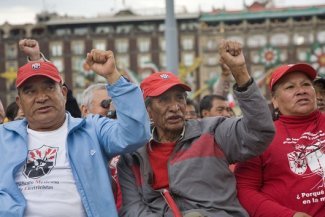In this 22 October 2021 photograph, supporters and demonstrators stand behind the five climate activists on hunger strike at the White House. The activists, who are part of the Sunrise Movement, are demanding that US president Joe Biden takes meaningful action on climate change in the face of threats to water down his US$3.5 trillion social and environmental spending agenda.
When Representative Alexandria Ocasio-Cortez introduced the Green New Deal (GND) to Congress in 2019, many within organised labour responded with deep scepticism. The GND was presented as a non-binding resolution that acknowledged the duty of the United States government to achieve net-zero emissions by 2050 while creating millions of high-wage jobs through “a fair and just transition for all communities and workers.”
The former president of the American Federation of Labor and Congress of Industrial Organizations (AFL-CIO), which represents over 12 million workers across 57 labour unions, told reporters at the time that trade unions had not been consulted before the legislation was released.
The term ‘just transition’ – mentioned only once in the 14-page resolution – is a framework originating in the US labour movement. It is a commitment to centre the workers and communities most impacted by the transition from an extractive economy to one that is carbon neutral. But as written in the 2019 resolution, the unions most affected by this transition believed too many questions were left unanswered.
Brad Markell, executive director of the AFL-CIO’s industrial union council and chair of its energy taskforce, says this apprehension is based on the experiences of the American working class over the past 40 years.
“Every time there’s a big change, workers get the short end of the stick, whether it’s deregulation, outsourcing, or free trade,” says Markell.
Markell has a background in manufacturing. In 1993 he was laid off from his factory job at a General Motors plant in Detroit, Michigan before being transferred to another plant an hour away in Toledo, Ohio. “I was one of the lucky ones,” he tells Equal Times. “People don’t often have the experience that when the highly paid job they’re in closes down, that there’s something else for them. In the absence of the creation of good family-supporting jobs in those communities, they’re going to hang on for dear life [to whatever work they can get].”
Getting past workers’ scepticism with terms like ‘just transition’ he says, will require investments in their communities that create good jobs. A 2021 report by the Energy Futures Initiative counts 345,000 workers in the solar industry in the United States and 114,000 in the wind industry, compared to the 1.6 million in oil, coal, and natural gas. These include solar panel installers, wind turbine technicians, engineers, electricians and more. “A big part of the problem is that most of the renewable sector is anti-union, and they’re providing low-quality jobs,” says Markell. “That’s what is so amazing about what is shaping up for offshore wind in the United States.”
Ørsted and Reimagine Appalachia – a landmark agreement and a blueprint
In late 2020, the North America’s Building Trades Unions (NABTU), which represents over three million workers across North America, signed a landmark agreement between the world’s largest offshore wind developer, a Danish energy company named Ørsted, to transition construction workers to the offshore wind industry. The agreement commits the company to train workers for future work at sea and use union labour for various projects planned along the US East Coast.
This agreement was a collaborative international effort that was facilitated by the Just Transition Centre (JTC) – a group within the International Trade Union Confederation (ITUC). In 2019, AFL-CIO president Liz Shuler, then secretary treasurer, went to Denmark and Norway to meet with Ørsted management. Markell credits Shuler for bringing the AFL-CIO and NABTU to the table.
In Denmark, local union advocacy laid the foundation for the agreement between NABTU and Ørsted by first getting the company to sign onto a global just transition pledge, explains JTC director Samantha Smith, and then through constant pressure from the Danish unions. Around the time Smith started her job at the JTC in 2016, she had a frank conversation with the Laborers’ International Union of North America (LiUNA) – a 500,000-member union with a heavy presence in the construction and energy sectors. LiUNA has been a particularly harsh critic of the Green New Deal, but when Smith spoke with them about a just transition they said: “We’ll build anything, but these big renewable energy companies have terrible labour standards.”
In 2017, the AFL-CIO passed a resolution committing it to “fight politically and legislatively” for workers affected by the transition to clean energy. The statement reads: “…the fastest and most equitable way to address climate change is for labour to be at the center of creating solutions that reduce emissions.” In the absence of federal legislation, a number of state and local AFL-CIO chapters have been busy laying the groundwork for the transition by putting together policies and talking to their membership.
Reimagine Appalachia is a broad coalition of environmental groups and labour organisations across four states in the heart of US coal country: Pennsylvania, Ohio, Kentucky, and West Virginia. In late May, the AFL-CIO presidents of each state chapter released a series of white papers laying out its vision for a “federal Appalachian infrastructure plan”. The coalition held months of meetings and listening sessions to discuss with members and labour leaders what a union-centred policy framework might look like before releasing its blueprint earlier this year. Their vision is rooted in rebuilding the working class in the region through federal investment and the creation of union jobs to build a green economy.
“Transforming Appalachia into a 21st-century sustainable economy – one that is good for workers, communities, and our health – will require significant federal resources,” their blueprint reads. “We can and should accept nothing less given the immense wealth extracted from Appalachia over the past centuries.”
The coalition operates on an understanding that federal climate legislation is imminent, and that labour must be ready once it’s passed. The blueprint proposes the creation of opportunities for workers in extractive industries, publicly funded projects with high labour standards, a modernised electric grid, clean manufacturing, sustainable transportation, and a modern version of the Civilian Conservation Corps – a New Deal jobs programme that put three million unemployed people to work planting trees and building parks during the Great Depression.
Union organising on climate and awaiting federal legislation
Other unions across the country are also spearheading a raft of ambitious climate projects.
In New York State, a coalition of labour unions representing 2.6 million workers across construction, transportation, energy, utilities, and more have formed Climate Jobs New York (CJNY). The group has thrown its support behind state legislation that puts New York on a path to reach 100 per cent renewable energy by 2040 and requires Project Labor Agreements (collective bargaining agreements between building trade unions and contractors) for all offshore wind development. Through alliances with local environmental groups, CJNY has also pushed for larger investments in renewable energy infrastructure. With five offshore wind projects currently under development, New York now has the nation’s largest wind pipeline, which is expected to meet almost half of New York City’s energy needs by 2035.
In the largest oil-producing state in the US, the Texas AFL-CIO voted in favour of a resolution backing the Texas Climate Jobs Project this July. If implemented, the plan is expected to create over a million jobs in the next 25 years through the development of wind and solar energy, while tackling the “intersecting crises” of the pandemic, income inequality, racial injustice and the climate emergency.
Weeks after the 2020 election, a coalition called Climate Jobs Rhode Island (RI) was formed between labour and environmental groups across the state.
Climate Jobs RI has put forward a number of goals that include “institutionalizing the concept of a Just Transition within all governmental agencies of the state,” reaching net-zero emissions by 2050, transitioning to renewable energy, and increasing apprenticeship training programs to retool workers with the skills they will need to work in a green economy.
So how does government policy tie-in with these union-led initiatives? Biden campaigned on a platform of rebuilding US manufacturing, and with it, the middle class through good union jobs that would put the US on the path to net-zero emissions by 2050. His Build Back Better Agenda includes a clean energy plan, a US$2 trillion investment in infrastructure, the creation of 10 million jobs with good wages, benefits, and worker protections, investments into the research and development of green technology, modernised schools, and public housing.
But despite the Democratic Party holding all three branches of government, federal legislation on climate, labour, and infrastructure has reached a stalemate thanks, in part, to two right-wing Democratic senators: Kyrsten Sinema of Arizona and Joe Manchin of West Virginia. West Virginia has the second-highest poverty rates in the nation largely due to a sharp decline in jobs within the coal mining industry, where Senator Manchin grew his fortunes. With the Republican Party in opposition to Biden’s agenda, these two votes within the Democratic Party will determine whether legislation will pass or not.
[Editor’s note: on Friday 5 November, the US House of Representatives finally passed a US$1.2 trillion infrastructure bill with US$47 billion set aside for climate resilience measures. But the fate of a second bill that earmarks a further US$555 billion to tackle climate change remains uncertain.]
In August, Manchin cast down a tie-breaking vote against a reconciliation bill that would have seen US$3.5 trillion invested in the country over ten years (less than half of what the US will spend on its military budget over the same period). As it was initially proposed, the legislation would have been the largest climate investment in the country’s history, but through several back-and-forth compromises within the Democratic Party, many of the initial elements have been stripped away. According to a recent investigation by The Intercept, Manchin has made US$4.5 million from his coal companies, despite claims that they have been held in a blind trust since he took office.
Markell over at the AFL-CIO, who served on the Biden-Harris transition team within the Department of Energy, is positive about the Biden administration’s commitment to just transition: “We have a president who is committed to unions and union jobs and understands what that means for families and communities. While at the same time, he is putting us on a path to meet the climate goals that science says we have to meet.” However, on the question of whether his legislative agenda will be enacted, Markell adds cautiously: “We’ll see if Congress wants to do its part.”













